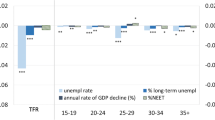Abstract
The paper analyzes changes in fertility rates recorded across the federal districts and regions of Russia over the period from 1990 to 2014. The analysis was based on β- and σ-convergence. It has been shown that differences in fertility rates tended either to decrease or increase in the considered period and were associated with specific events in the country’s socioeconomic development. The patterns were similar at the level of federal districts, but the values of variation were lower. There were no significant patterns of convergence in the Siberian and Ural federal districts, divergence was observed in the Northwestern and Volga federal districts, and the differences in other districts tended to decrease. Demographic policy measures had an appreciable effect on the behavior of the population, but additional measures are needed to reduce interregional differences, since there are “clubs” of regions according to the fertility rate that may negatively interfere with the country’s socioeconomic development. The concluding section of the paper contains recommendations for demographic policy—future measures should be aimed at changing reproductive attitudes in regions with low fertility rates.
Similar content being viewed by others
References
Arkhangel’skii, V.N. and Dzhanaeva, N.G., Regional features of birth rate dynamics and demographic policy, Uroven’ Zhizni Naseleniya Reg. Ross., 2014, no. 1, pp. 73–82.
Balash, O.S., Spatial analysis of the convergence of Russian regions, Izv. Sarat. Univ., Ser. Ekon. Uprav. Pravo, 2012, vol. 12, no. 4, pp. 45–52.
Brovkova, A.V., Convergence factors of Russian regions and their place in the reproduction cycle of human potential, Izv. Sarat. Univ., Ser. Ekon. Uprav. Pravo, 2015, vol. 15, no. 2, pp. 143–150.
Vakulenko, E.S., Does population migration lead to interregional convergence in Russia? Vestn. Novosib. Gos. Univ. Ekon. Uprav., 2013, no. 4, pp. 239–264.
Glushchenko, K.P., Myths about beta-convergence, Zh. Nov. Ekon. Assots., 2012, no. 4 (16), pp. 26–44.
Golyashev, A.V. and Grigor’ev, L.M., Tipy rossiiskikh regionov: ustoichivost’ i sdvigi v 2003–2013 godakh (Types of Russian Regions: Stability and Shifts in 2003–2013), Moscow: Anal. Tsentr Pravit. RF, 2014.
Grigor’ev, L.M., Urozhaeva, Yu.V., and Ivanov, D.S., Synthetic classification of regions as the basis for regional policy, in Rossiiskie regiony: ekonomicheskii krizis i problemy modernizatsii (Russian Regions: Economic Crisis and Problems of Modernization), Grigor’ev, L.M., Zubarevich, N.V., and Khasaev, G.R., Eds., Moscow: TEIS, 2011, pp. 34–53.
Kvasha, A.Ya., Demograficheskaya politika SSSR (Demographic Policy of the Soviet Union), Moscow: Finansy i Statistika, 1981.
Pavlov, Yu.V. and Koroleva, E.N., Spatial interactions: analysis based on global and local Moran indices, Prostranstvennaya Ekon., 2014, no. 3, pp. 95–110.
Semerikova, E.V., Unemployment in Western and Eastern Germany: spatial analysis of panel data, Prikl. Ekonometr., 2014, no. 3 (65), pp. 107–132.
Speshilova, N.V. and Larina, T.N., Statistical analysis of social differentiation of Russian regions based on convergence models, Reg. Ekon.: Teor. Prakt., 2010, no. 44, pp. 18–23.
Kotzamanis, B. and Duquesne, M.N., Les disparites demographiques departementales en Grece: convergence ou divergence? Espace Popul. Soc., 2004, no. 3, pp. 641–664.
Lanzieri, G., EUROPOP 2008: A set of population projections for the European Union, The XXVI IUSSP Int. Population Conf., Busan, 2013. https://doi.org/iussp2009.princeton.edu/papers/91070/. Accessed April 15, 2016.
Sala-i-Martin, X., The classical approach to convergence analysis, Econ. J., 1996, vol. 106, no. 437, pp. 1019–1036.
Wilson, C., On the scale of global demographic convergence 1950–2000, Popul. Dev. Rev., 2001, vol. 27, no. 1, pp. 155–171.
Author information
Authors and Affiliations
Corresponding author
Additional information
Original Russian Text © A.L. Sinitsa, 2017, published in Region: Ekonomika i Sotsiologiya, 2017, No. 2 (94), pp. 152–173.
Rights and permissions
About this article
Cite this article
Sinitsa, A.L. Fertility Rates in Russian Regions: Convergence or Divergence. Reg. Res. Russ. 8, 169–177 (2018). https://doi.org/10.1134/S2079970518020077
Received:
Published:
Issue Date:
DOI: https://doi.org/10.1134/S2079970518020077




